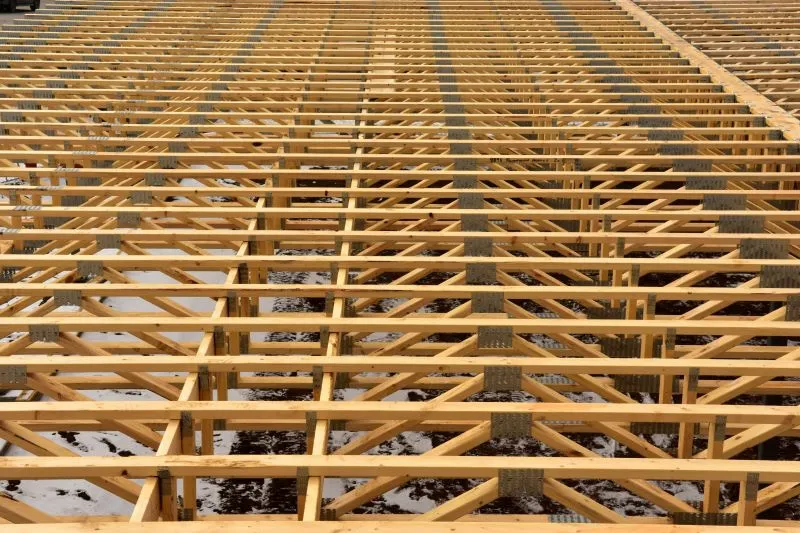What Are I-Joists?
I-Joists, sometimes referred to as engineered wood joists, are structural components made from a combination of materials designed to optimize strength and minimize waste. Typically, they consist of top and bottom flanges made from solid lumber or laminated veneer lumber (LVL), connected by a web of oriented strand board (OSB) or plywood. This shape mimics the capital letter "I," a design that maximizes load-bearing capacity while minimizing material use.
Originally developed in the 1960s, I-Joists have become increasingly popular over the decades due to their high performance and consistent quality compared to traditional sawn lumber. Their precision manufacturing ensures fewer defects like warping, splitting, or twisting, issues often found in natural wood products.
Superior Strength-to-Weight Ratio
One of the key advantages of I-Joists is their exceptional strength-to-weight ratio. Large-scale constructions, such as commercial complexes, hotels, and multi-story residential buildings, demand materials that can support significant loads without adding unnecessary weight to the structure.
Because of their engineered design, I-Joists can span greater distances than traditional timber without needing additional support beams. This not only reduces the overall material costs but also allows for more open floor plans, a feature highly prized in contemporary architectural designs. The strength-to-weight efficiency also means fewer resources are needed to transport and install these components, promoting faster project completion and reduced environmental impact.
Enhanced Dimensional Stability
Large-scale constructions often face long-term stresses due to shifting loads, environmental changes, and material aging. Traditional lumber can be susceptible to moisture fluctuations, leading to warping, shrinking, or swelling, all of which can compromise structural integrity over time.
In contrast, I-Joists exhibit superior dimensional stability. Their engineered composition resists the common problems associated with moisture exposure, maintaining their shape and strength for decades. This stability not only ensures safety but also reduces the need for costly repairs and maintenance down the road. Builders appreciate this reliability, particularly in projects where longevity and low lifecycle costs are priorities.
Versatility in Design and Application
Another reason I-Joists enhance structural integrity is their flexibility in application. They can be used for floor joists, roof rafters, and even wall studs in certain situations. Their adaptability allows engineers to design complex structures without being limited by the constraints of traditional lumber sizes or performance capabilities.
Moreover, manufacturers offer I-Joists in a variety of sizes, flange widths, and depths, providing tailored solutions for different project needs. Custom sizing ensures that load requirements and design specifications are met precisely, reducing the risk of structural deficiencies.
Additionally, their compatibility with various fastening systems and construction techniques makes them an ideal choice for hybrid structures that combine steel, concrete, and wood. In mixed-material projects, using I-Joists can help bridge the gap between different materials without sacrificing strength or design integrity.
Fire Resistance and Building Code Compliance
Fire resistance is a critical consideration in large-scale constructions. Many building codes now require that structural elements in residential and commercial buildings meet specific fire performance standards. Some manufacturers produce I-Joists with fire-rated coatings or assemblies, enhancing their ability to withstand high temperatures for longer periods compared to unprotected traditional lumber.
Meeting these requirements not only ensures code compliance but also provides occupants with added protection, crucial for multi-story or densely populated structures. When properly integrated into a building’s fire safety strategy, I-Joists can significantly bolster the overall resilience of the construction.
Sustainability and Resource Efficiency
Modern construction is increasingly focused on sustainability, and I-Joists contribute positively in this regard. By using engineered wood products, builders reduce dependence on old-growth forests and optimize the use of raw materials. The manufacturing process for I-Joists makes efficient use of wood fiber, often using fast-growing species and wood scraps that would otherwise go to waste.
This efficient use of resources not only helps conserve forests but also reduces the carbon footprint of construction projects. Given that large-scale constructions inherently involve extensive material consumption, selecting sustainable options like I-Joists can make a meaningful impact on environmental stewardship.
When it comes to large-scale construction projects, ensuring structural integrity is paramount. I-Joists provide an unparalleled combination of strength, stability, versatility, and sustainability. Their engineered design addresses many of the shortcomings associated with traditional lumber, offering solutions that align with modern building needs.
Whether it’s spanning vast floor areas without intermediate supports, maintaining shape and strength over time, or meeting stringent fire safety codes, I-Joists consistently prove their worth. As the construction industry continues to evolve toward more efficient and sustainable practices, the role of engineered wood products like I-Joists will only grow more significant in shaping the skylines of the future.
